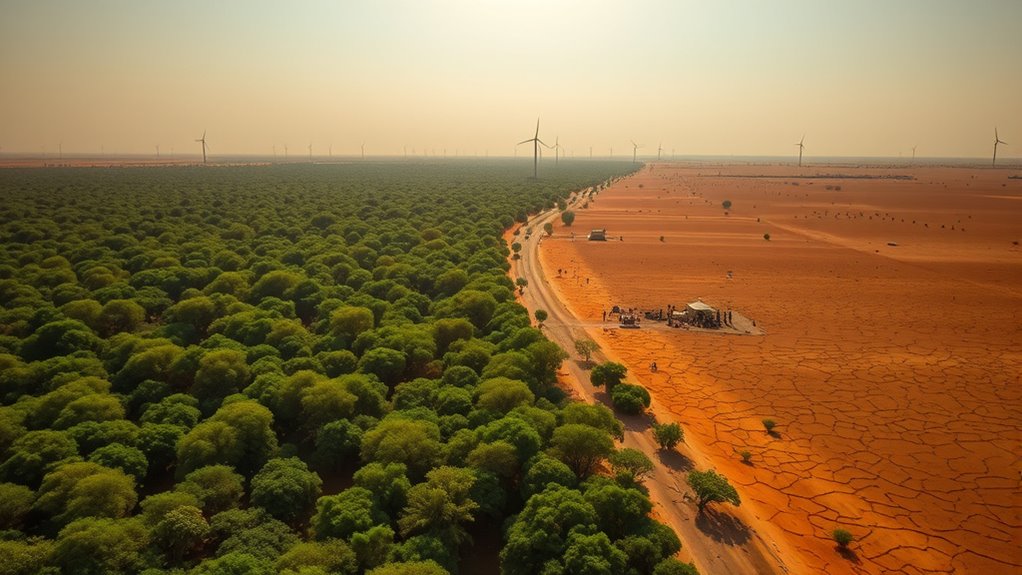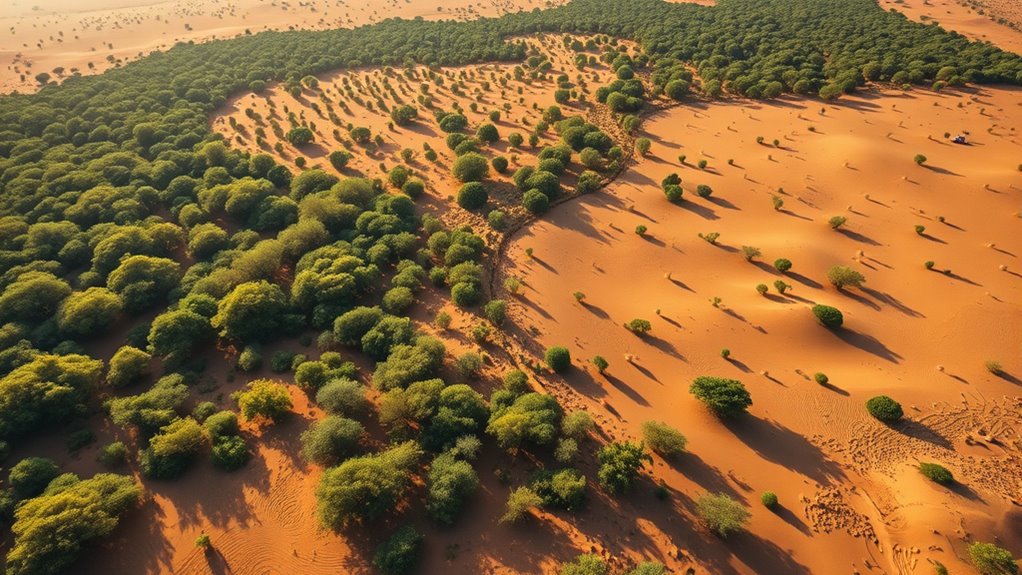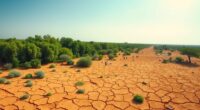The Great Green Wall is Africa’s ambitious effort to stop desertification in the Sahel by planting a vast network of trees and promoting sustainable land use. It involves governments, communities, and organizations working together to restore degraded lands, improve local climates, and support livelihoods. By combining tree planting with sustainable farming practices, the project aims to create resilient ecosystems and economic opportunities. To discover more about how this bold initiative is transforming Africa’s landscape, keep exploring its impactful efforts.
Key Takeaways
- The Great Green Wall is a transcontinental initiative to combat desertification across Africa’s Sahel region through reforestation and land restoration.
- It aims to create a mosaic of green spaces that stabilize soil, improve microclimates, and halt desert expansion.
- The project involves governments, communities, and organizations implementing sustainable agriculture and tree planting practices.
- Benefits include enhanced biodiversity, improved local livelihoods, and increased climate resilience for vulnerable communities.
- It symbolizes hope, resilience, and collective effort towards sustainable development and environmental restoration in Africa.

The Great Green Wall Project is an ambitious initiative aimed at combating desertification and restoring degraded land across Africa’s Sahel region. You might wonder how planting a wall of trees can make such a difference, but it’s more than just a natural barrier. This project seeks to transform the landscape into a thriving, sustainable environment by promoting sustainable agriculture practices and preventing further land degradation. The goal is to create a mosaic of green spaces that can halt the advance of the desert, improve local climates, and support communities that depend on the land for their livelihoods.
As you look into this project, you’ll see that sustainable agriculture plays a crucial role. Farmers in the region are encouraged to adopt methods that conserve water, improve soil fertility, and reduce erosion. Techniques like agroforestry, crop diversification, and the use of drought-resistant crops help communities adapt to changing environmental conditions. These practices not only boost food security but also contribute to desertification mitigation by maintaining healthy soil and preventing land from turning to dust. The project aims to empower local farmers to implement these methods, ensuring that land remains productive for generations to come.
You’ll also notice that the success of the Great Green Wall hinges on collaborative efforts between governments, local communities, and international organizations. This collective approach ensures that the focus isn’t just on planting trees but on creating a resilient ecosystem. Trees help retain soil moisture, reduce wind erosion, and create microclimates that support other plant and animal life. When combined with sustainable agriculture practices, these efforts help stabilize the land, making it less vulnerable to desertification. You might find that engaging local communities in tree planting and land management fosters a sense of ownership and responsibility, which is critical for long-term success. Additionally, understanding the importance of cost of living adjustments in land management and economic development can support sustainable growth in the region.
In addition, the project promotes awareness and education about desertification mitigation. By understanding the importance of sustainable land use, communities become active participants in restoring their environment. The initiative also offers economic opportunities, such as eco-tourism and sustainable harvesting of forest products, which can improve livelihoods and reduce the pressure on remaining natural resources. Your role in supporting or learning about such efforts can help amplify these positive impacts, ensuring that the Great Green Wall isn’t just a line of trees but a symbol of resilience, hope, and sustainable development across Africa’s Sahel.
Frequently Asked Questions
How Is the Project Funded Long-Term?
You might wonder how the project is funded long-term. It relies on diverse funding strategies, including government contributions, international donors, and private sector investments. Active donor engagement plays a key role, as they continuously support and renew commitments to guarantee sustainability. You can see that this multi-pronged approach helps maintain momentum, adapt to challenges, and secure ongoing resources, making the project resilient against funding uncertainties over time.
What Communities Benefit Most From the Wall?
Imagine a lush green corridor weaving through barren lands—this is where your community thrives. You benefit most through community engagement, where your voices shape the project, and traditional knowledge guides sustainable practices. As trees take root, local farmers find new hope, and families enjoy better food security. By collaborating closely, you help transform arid landscapes into thriving ecosystems, ensuring your community’s resilience and future prosperity.
How Will Climate Change Impact Its Success?
You might wonder how climate change will influence success. It challenges your efforts by increasing droughts, making drought adaptation vital. Climate resilience becomes necessary, as unpredictable weather can hinder vegetation growth and restore land. If you don’t plan for these changes, your project’s effectiveness could decline. Building resilience now helps guarantee that the Green Wall can withstand climate shifts, supporting communities and ecosystems in adapting to future climate realities.
Are There Any Technological Innovations Involved?
You’ll find that technological innovations play a key role in enhancing drought resilience and soil regeneration. Tools like satellite monitoring help track environmental changes, while drone technology assists in planting and maintaining vegetation. These advancements enable you to better combat desertification by restoring soil health and improving water management. Together, these innovations support sustainable land use, making efforts more effective and increasing the project’s chances of success in combating climate challenges.
How Is Progress Monitored and Evaluated?
You can monitor and evaluate progress through satellite monitoring, which provides real-time data on vegetation growth and land restoration. Community participation also plays a crucial role, as local communities help assess the project’s impact, report changes, and maintain sustainable practices. Together, these methods ensure accurate tracking of the project’s success, enabling adjustments and fostering accountability for long-term environmental and social benefits.
Conclusion
As you stand before the Great Green Wall, you witness a living tapestry weaving hope into Africa’s desert heart. This project isn’t just a strip of trees; it’s a breath of life, a shield against the relentless march of desert sands. With every sapling planted, you help forge a future where resilience blooms amidst adversity. Together, you become part of a symphony of renewal, turning the barren into a lush promise of tomorrow’s verdant dawn.









